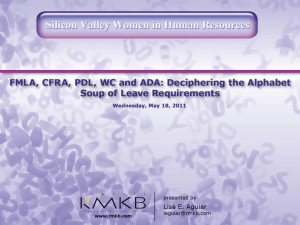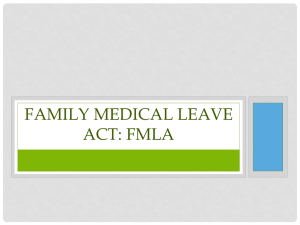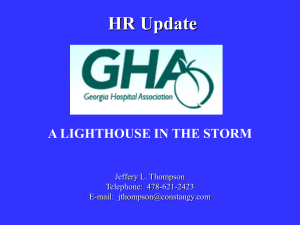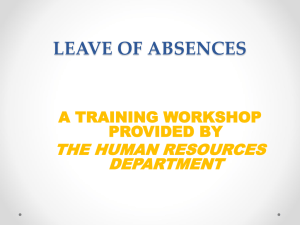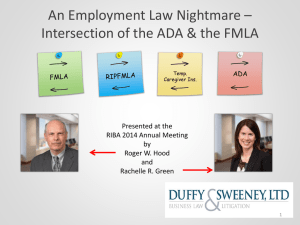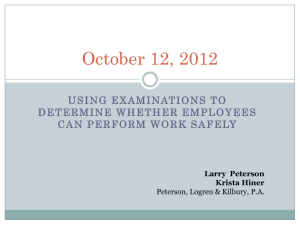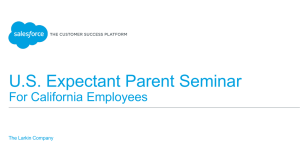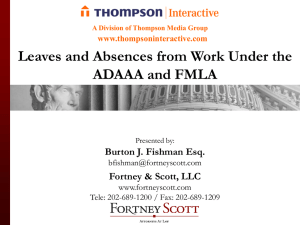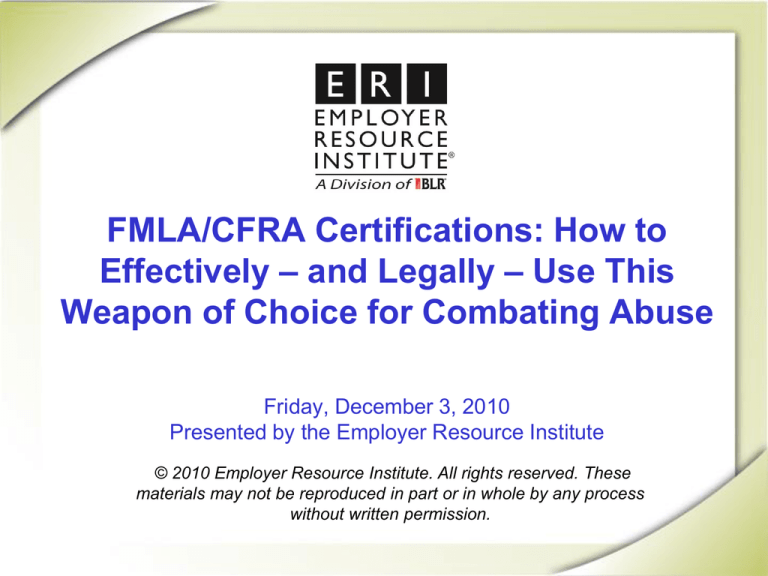
FMLA/CFRA Certifications: How to
Effectively – and Legally – Use This
Weapon of Choice for Combating Abuse
Friday, December 3, 2010
Presented by the Employer Resource Institute
© 2010 Employer Resource Institute. All rights reserved. These
materials may not be reproduced in part or in whole by any process
without written permission.
Disclaimers
• This webinar is designed to provide accurate and authoritative
information about the subject matter covered. It is sold with the
understanding that the publisher is not engaged in rendering legal,
accounting, or other professional services.
• This webinar provides general information only and does not
constitute legal advice. No attorney-client relationship has been
created. If legal advice or other expert assistance is required, the
services of a competent professional should be sought. We
recommend that you consult with qualified local counsel familiar
with your specific situation before taking any action.
© 2010 Employer Resource Institute. All Rights Reserved
About Today’s Presentation
• This entire webinar is being recorded and all of the
accompanying materials are protected by copyright.
• If at any time during today’s event you experience technical
issues, please call (877) 297-2901 to reach an operator.
• Questions or comments about this webinar?
Employer Resource Institute
(800) 695-7178
custserv@employeradvice.com
© 2010 Employer Resource Institute. All Rights Reserved
Recertification Credit
This program, ORG-PROGRAM-78752, has been approved for 1.5
recertification credit hours toward PHR® and SPHR® recertification
through the Human Resource Certification Institute (HRCI).
Please be sure to note the program ID number on your recertification
application form.
For more information about certification or recertification, please visit
the HRCI home page at www.hrci.org.
The use of the above seal is not an endorsement by HRCI of the quality of the program.
It means that this program has met HRCI’s criteria to be pre-approved for recertification.
© 2010 Employer Resource Institute. All Rights Reserved
About Our Speaker
Mark J. Jacobs, Esq. is a partner in the Irvine office of Fisher & Phillips,
LLP. His practice is focused on defending employment related lawsuits
and administrative complaints on a variety of issues, including
harassment, retaliation, and discrimination. Jacobs represents employers
in both state and federal courts as well as before state and federal
agencies, such as the Equal Employment Opportunity Commission, the
California Department of Fair Employment and Housing, and the Division
of Labor Standards Enforcement and has expertise in handling complex,
multi-plaintiff harassment and discrimination matters, wage & hour and
other administrative matters. A significant portion of his practice is
devoted to preventive employee relations programs that include
supervisory training and the development and administration of effective
human resources policies and practices.
© 2010 Employer Resource Institute. All Rights Reserved
Solutions at Work
Managing Leaves of Absence
Presented by
Mark J. Jacobs
Neal A. Fisher Jr.
Fisher & Phillips LLP
Attorneys at Law
www.laborlawyers.com
Atlanta • Charlotte • Chicago • Columbia • Dallas • Denver • Fort Lauderdale • Houston • Irvine • Kansas City • Las Vegas • Louisville
New Jersey • New Orleans • Orlando • Philadelphia • Phoenix • Portland, ME • Portland, OR • San Diego • San Francisco • Tampa
6
Managing Leave
Laws Successfully
Overview of Presentation
The Nuts and Bolts of Relevant Federal and State
Laws
Managing Return-To Work Issues
Keeping Leave Law Fraud To a Minimum
Disciplining and Terminating For Absenteeism
Without Inviting A Lawsuit
Emerging issues
8
Why Is This So Important?
What is your number one priority in administering
leaves of absence?
** Protect The Company **
The best defense is a good offense
Actively administer each claim from start to finish
Learn to recognize interplay between various
federal and state laws
9
Different Laws Involving Leaves of
Absence
Family and Medical Leave Act (FMLA)
California Family Rights Act (CFRA)
CA Pregnancy Disability Leave Act (PDL)
California Fair Employment & Housing Act
(FEHA)
Americans With Disabilities Act (ADA)
Workers’ Compensation
Paid Family Leave (FTDI)
10
Each Law Focuses On A Different
Element Of The Disability Process
You always want to be conscious
of which law is governing at that
particular point in time.
11
Each Law Focuses On A Different
Element Of The Disability Process
CFRA
FEHA
FMLA
Workers’
Comp
CAL PDL
FTDI
ADA
12
Figure Out Which Laws Apply And Stay
Focused On Each Law Until It No
Longer Applies
CFRA
FMLA
FTDI
13
Overview of FMLA/CFRA
CFRA
FMLA
14
FMLA/CFRA Is Concerned With:
Providing a minimum level of unpaid, job-protected
leave to eligible employees;
Covering those who suffer from a serious health
condition;
Cover those providing Military Caregiver Leave or
Exigency Leave; and
Protecting those employees from adverse treatment
because of the need for leave.
15
ADA/FEHA Attempts To Eliminate
Workplace Disability Discrimination By:
Emphasizing on what an employee can do as
opposed to focusing on employee’s limitations;
Requiring employers to evaluate an individual’s
fitness to perform the essential functions of the
job on a case-by-case basis; and
Considering any reasonable accommodation in
the process.
16
Definitions May Overlap
Not
all “disabilities” under ADA/FEHA are
“serious health conditions” under
FMLA/CFRA.
E.g. an employee with a glass eye
Not
all “serious health conditions” under
FMLA/CFRA are “disabilities” under
ADA/FEHA
E.g. an employee with a broken leg
17
FMLA/CFRA vs. ADA/FEHA Leaves
FMLA available for family
members
FMLA limited to 12 weeks
FMLA has length of
service requirements
FMLA has no “undue
hardship” defense
ADA is available for
employees only
ADA is open ended as
“reasonable
accommodation”
ADA has no length of
service requirements
ADA has undue hardship
defense
Both have different re-instatement rights.
Transfer requirements also vary.
18
FMLA/CFRA vs. ADA/FEHA Leaves
ADA/FEHA requires accommodation if employee
cannot perform prior job without
accommodation but FMLA/CFRA does not
consider accommodation
ADA/FEHA accommodations must be reasonable
and do not necessarily have to be the
employee’s first choice of accommodation
ADA/FEHA obligates an employer to engage in
the interactive process
19
Definitions May Differ
Pregnancy,
childbirth and related medical
conditions are considered serious health
conditions under the FMLA
Pregnancy is not a covered qualifying
event under California’s Family Rights Act
Disabilities arising from a female employee’s
pregnancy, childbirth or related medical
condition are covered under California’s
Pregnancy Disability Act
20
Workers’ Compensation Laws
Emphasize . . .
What
employee cannot do by focusing on
the nature and percentage of disability;
So as to provide suitable compensation for
lost earnings;
Resulting from a work-related injury.
21
FMLA/CFRA vs. Workers’
Compensation
Leaves Covered by both FMLA/CFRA and WC
If work-related injury that keeps employee from
working
Employers frequently forget to designate the leave
as FMLA/CFRA qualifying
If unsure, at least preliminarily designate as
FMLA/CFRA and provide Employee FMLA paperwork
Allows time to count against 12 week entitlement
22
FMLA/CFRA vs. Workers’ Compensation
If the employee has been on a workers’
compensation leave of absence during which
FMLA has been taken concurrently, and the
employee exhausts all 12-weeks of FMLA leave
and is still unable to return to work, the
employee no longer has the protections of the
FMLA.
However, employer MUST look to workers’
compensation laws, as well as ADA/FEHA
23
Defining Employer Rights &
Responsibilities Under State & Federal
Disability, Leave & Absence Laws
The Nuts and Bolts of Various Federal
and State Leave Laws
24
Keys to Managing Leaves of Absence
Focus on which leave of absence currently applies to
the leave of absence
Analyze each leave of absence independently
Communicate with the employee regarding his/her
rights and responsibilities during the leave
Evaluate other potential laws governing leave of
absence either concurrently or at the end of the
previous coverage
Consistency – treat all employee leaves the same
25
Federal Family and
Medical Leave,
California’s Family
Rights Act, and
California’s
Pregnancy
Disability Leave
26
Family And Medical Leave Acts
The federal Family and Medical Leave Act
(“FMLA”) and the California (Moore-BrownRoberti) Family Rights Act (“CFRA”) entitle
eligible employees to take an unpaid, jobprotected leave of absence up to 12 workweeks
in a 12-month period for certain qualifying
reasons.
Both laws prohibit companies from interfering
with or retaliating against employees for
exercising their right to FMLA/CFRA leave.
27
Key Differences Between Leave
Duration Under FMLA & CFRA
Pregnancy Disability Leave Law (PDL)
The FMLA includes disabilities related to pregnancy as a serious health
condition
The CFRA expressly excludes disabilities related to pregnancy
In California, the PDL governs a female employee’s right to a leave of
absence for disabilities due to the pregnancy, childbirth or related
medical conditions.
Child care leave under CFRA may be taken in increments
of two weeks and twice in increments of less than two
weeks
Under the FMLA, “bonding time” with the child must be taken all at
once unless the employer agrees to the contrary
28
California’s Pregnancy
Disability Leave Law (“PDL”)
PDL is for any period(s) of actual disability
caused by the employee’s pregnancy, childbirth
or related medical condition up to 4 months per
pregnancy
4 months = 88 days for full-time employee
PDL covers time off for:
Prenatal care
Severe morning sickness
Doctor-ordered bed rest
Childbirth
Recovery from childbirth
29
California’s Pregnancy
Disability Leave Law (“PDL”)
There is no eligibility requirement
Employee can request PDL time off work on her first
day of work
Provides up to 4 months of unpaid, jobprotected leave as needed
Does not need to be continuous; as needed
Temporary transfers are permissible
Only applies if employee is actually disabled due
to pregnancy or related medical conditions
30
California’s Pregnancy Disability
Leave Law
All three laws interact
Up to first 12 weeks will be BOTH FMLA
and Pregnancy Disability Leave
At end of disability – then 12 weeks of
leave under CFRA
Remember CFRA does not apply to pregnancy related
disabilities
Total of up to 7 months job protected
leave
Never forget the duty to accommodate a
disability under ADA/FEHA
31
What are an employer’s obligations prior to
and during an employee’s leave?
An
employer’s primary obligation is to
provide proper notification of an
employee’s rights and responsibilities
during an FMLA/CFRA leave.
Notification obligations occur prior to a
leave, during a leave and upon conclusion
of the leave.
32
What are an employer’s
Whatobligations
are an employer’s
obligations
prior
to
prior to and during
and during an employee’s leave?
an employee’s leave?
How
does an employer satisfy these
obligations?
Employee Handbook
FMLA Pre-Designation Form
FMLA Medical Certification Form
FMLA Designation Form
FMLA Status Letters
33
Analyze Each Claim From
Beginning To End
Step 1
Does The
FMLA Apply
To Your
Company?
34
Analyze Each Claim From
Beginning To End
Step 1
Does The
FMLA Apply
To Your
Company?
Step 2
Is the
employee
eligible for
FMLA leave?
35
Is The Employee Entitled To
FMLA/CFRA Leave?
Only employees who meet certain requirements
are entitled to job protected leave under the
FMLA/CFRA
2 part test:
(1) Does the employee satisfy the eligibility
requirements under the FMLA?
(2) If yes, does the employee have FMLA leave
available or has the employee previously exhausted
his/her FMLA leave rights?
36
Analyze Each Claim From
Beginning To End
Step 1
Does The
FMLA Apply
To Your
Company?
Step 2
Part 1
Part 2
Does the
employee meet
the FMLA
eligibility
requirements?
Does the
employee have
available FMLA
leave?
37
Part 1 – Is the Employee Eligible For
Leave Under The FMLA/CFRA?
Whenever an employee requests a leave of
absence, the first question to ask is whether the
employee meets the three requirements.
What are the 3 eligibility criteria:
1._________________________________
2._________________________________
3._________________________________
38
Employee Eligibility Requirement #1
1. Employee has worked for the Company
for at least 12 months (e.g. 52 weeks)
12 months do not have to be consecutive
Look at employee’s entire employment
history with the Company
Count any week in which the employee is
maintained on the payroll
39
Employee Eligibility Requirement #2
2. Employee has worked for the Company
for at least 1,250 hours during the 12
consecutive months preceding the start
of the leave (not the date of the
requests the leave)
For example, if an employee notifies you on
June 15th that they will be having surgery on
August 1, you determine the number of hours
worked as of August 1 – not June 15th
AND…
40
Employee Eligibility Requirement #3
3.
Employee works at a work site where there
are at least 50 employees within a 75-mile
radius
Test can be met either when leave is requested or
when taken
Salespeople are deemed to work at their “home
base” worksite (where work assignments originate
or where they report for work).
Temporary employees count for calculating the 50
employee coverage threshold if they have a
“continuing employment relationship” (DOL August
5, 2004 Opinion Letter)
41
Analyze Each Claim From
Beginning To End
Step 1
Does The
FMLA Apply
To Your
Company?
Step 2
Part 1
Part 2
Does the
employee meet
the FMLA
eligibility
requirements?
Does the
employee have
available FMLA
leave?
42
Part 2 Of Employee Eligibility Analysis
FMLA/CFRA leave does not necessarily mean that
they are entitled to take FMLA/CFRA leave
An employee may have already exhausted leave rights or
part of his/her leave rights
You have to determine whether the employee has
any available FMLA leave available
If the employee has previously taken leave, determine if the
employee has exhausted all 12 weeks of leave or how much
time the employee has remaining
You want to manage the employee’s expectations of how
much job-protected leave he/she can take
43
Ensure Compliance with the
Family and Medical Leave Act
12 Workweeks in a 12-month period
“Workweek” = the employee’s normally
scheduled week
Examples – Alternative Workweek Schedules;
Part-time employees
12-Month
period must be defined in the
Company’s policy (e.g. handbook)
If Company fails to specify which method it uses
to calculate the 12-month period, the employee
is entitled to the most beneficial method
44
Calculating FMLA leave
1) “Rolling” Method. The best method of
calculating the 12-week leave period is the
“rolling” method by which the employer looks
back in time to the last FMLA leave and calculates
one year from that time. This is the only method
that avoids employees’ stacking.
2) Calendar Year. The employer may also use the
calendar-year method by which the employer
provides up to 12 workweeks of leave to each
eligible employee each calendar year.
3)
Twelve-Month Period. The employer may also
institute a policy that provides up to 12 weeks of
FMLA leave in any 12-month period.
45
Example Of Rolling Method
Scenario #1: Employee takes 4 weeks off starting February 1, 2009; then 4 more weeks off beginning June 1, 2009; then 4 more weeks off
beginning December 1, 2009. Then the employee requests additional leave beginning January 1, 2010.
Calendar Year 2009
Calendar Year 2010
Jan Feb Mar. Apr. May June July Aug. Sept. Oct. Nov. Dec. Jan Feb Mar. Apr. May June
# weeks taken
4
4
4
12
11
10
9
8
7
6
5
4
3
2
Employee requests
1
additional leave Jan. 1
Step #1:
Look backwards at the preceeding 12 months from the date the employee requests the leave
Step #2:
Take the sum of the # weeks used in preceeding 12 months (e.g. 4 weeks in Feb. + 4 weeks in June + 4 weeks in December = 12 weeks)
Step #3:
Subtract the # of weeks used in preceeding 12 months from the 12 weeks of FMLA entitled leave (e.g. FMLA 12 weeks - 12 weeks used = 0)
Step #4:
Determine the # of remaining weeks the employee is entitled to use (e.g. in this scenario, zero b/c the employee has exhausted all 12 weeks in
the preceeding 12 months as of the date of the employee's request for additional leave)
46
Example Of Rolling Method
Calendar Year 2009
Calendar Year 2010
Jan Feb Mar. Apr. May June July Aug. Sept. Oct. Nov. Dec. Jan Feb Mar. Apr. May June
# weeks taken
4
4
4
12
11
10
9
8
7
6
5
4
3
2
1
Employee requests
additional leave Mar. 1
Step #1:
Look backwards at the preceeding 12 months from the date the employee requests the leave
Step #2:
Take the sum of the # weeks used in preceeding 12 months (e.g. 4 weeks in June + 4 weeks in December = 8 weeks)
Step #3:
Subtract the # of weeks used in preceeding 12 months from the 12 weeks of FMLA entitled leave (e.g. FMLA 12 weeks - 8 weeks used = 4)
Step #4:
Determine the # of remaining weeks the employee is entitled to use (e.g. in this scenario, 4 weeks b/c the employee has only used 8 weeks in the
preceeding 12 months as of the date of the employee's request for additional leave)
47
Example Of Rolling Method
Scenario #3: Employee takes 6 weeks off starting May 1, 2009; then 1 week off beginning July 1, 2009; then 1 more week off beginning Sept. 1,
2009; then 1 more week off beginning Nov. 1, 2009. Then the employee requests additional leave beginning May 1, 2010.
Calendar Year 2009
Calendar Year 2010
Jan Feb Mar. Apr. May June July Aug. Sept. Oct. Nov. Dec. Jan Feb Mar. Apr. May June
# weeks taken 2 2
2 6
1
1
1
12
11
10
9
8
7
6
5
4
3
2
1
Employee requests
additional leave May. 1
Step #1:
Look backwards at the preceeding 12 months from the date the employee requests the leave
Step #2:
Take the sum of the # weeks used in preceeding 12 months (e.g. 6 weeks in May + 1 week in July + 1 week in Sept. + 1 week in Nov. = 9 weeks)
Step #3:
Subtract the # of weeks used in preceeding 12 months from the 12 weeks of FMLA entitled leave (e.g. FMLA 12 weeks - 9 weeks used = 3)
Step #4:
Determine the # of remaining weeks the employee is entitled to use (e.g. in this scenario, 3 weeks b/c the employee has only used 9 weeks in the
preceeding 12 months as of the date of the employee's request for additional leave)
48
Analyze Each Claim From
Beginning To End
Step 1
Step 2
Step 3
Does The
FMLA Apply
To Your
Company?
Is the
employee
eligible for
FMLA leave?
Does the
reason for
the leave
qualify
under
FMLA?
49
Step #3
The next step in the analysis is to
determine whether the reason for
the employee’s leave of absence is
covered under the FMLA/CFRA
50
Six Qualified FMLA Requests
1)
2)
For employee’s own “serious health condition” that makes
him/her unable to perform job.
To provide care for employee’s immediate family member
with “serious health condition.”
Spouse
Child
Includes common law marriage
if recognized by state, domestic partner
Child must be under 18 or incapable of self-care due to disability
Includes child of a domestic partner in CA
Employee’s parent (not spouse’s parent).
51
Six Qualified FMLA Requests
For the birth of a child, and to care for the
newborn child.
3)
•
4)
Remember, pregnancy disabilities and leaves
for the birth of a child are not covered under
California’s Family Rights Act; they are covered
exclusively under California’s PDL
For the placement of a child with the
employee for adoption or foster care.
52
Six Qualified FMLA Requests
To provide care for a covered service member with
a serious injury or illness related to certain types of
military service.
5)
Spouse, son, daughter, parent of “next of kin” can take
26 workweeks
•
•
•
•
•
“Next of kin”= nearest blood relative
“Serious illness or injury”= results in recuperation,
therapy, medical treatment, is in outpatient status or is
on the temporary disability retired list in the Armed
Forces
Can require certification but not recertification/second
opinions
Intermittent leave available
53
Six Qualified FMLA Requests
Exigent Circumstances Military Leave
6)
Spouse, son, daughter or parent is on active duty or
notified of an impending call to active duty
Qualifying exigencies:
•
•
•
•
•
•
•
•
•
•
short notice deployment,
military events,
childcare and school activities,
financial and life arrangements,
counseling,
rest and recuperation, and
post-deployment activities
Can request copy of active duty orders/certification
54
Hypothetical
Employee
requests leave of absence to
care for her mother in law while she is
undergoing chemotherapy. The doctor
submits a proper certification form in
support of the employee’s leave.
Is the employee entitled to FMLA leave?
55
Analyze Each Claim From
Beginning To End
Step 1
Step 2
Step 3
Step 4
Does The
FMLA Apply
To Your
Company?
Is the
employee
eligible for
FMLA leave?
Does the
reason for
the leave
qualify
under
FMLA?
Is there a
serious
health
condition?
56
To Qualify For FMLA Leave There Must
Be A Serious Health Condition
To
qualify for protection under the FMLA the
employee, or the employee’s immediate
family member must have a “serious health
condition.”
57
What Counts as a Serious Health
Condition?
An illness, injury, impairment, or physical or
mental condition of the care recipient that
involves:
(a) Hospital / Inpatient care; or
(b) Continuing treatment by a
physician or practitioner
The “continuing treatment” category includes many
different types of treatment and is the basis for leaves
that you might not otherwise consider to be “serious
health conditions.”
58
Continuing Treatment Includes…
Continuing Treatment
A period of incapacity of more than three full consecutive calendar
days:
Treatment two or more times by a HCP must occur within 30-day
Treatment once, plus continuing regimen of treatment
period (unless extenuating circumstances exist); or
First treatment must occur within seven days of first day of incapacity
Chronic conditions: visits for treatment must occur at least 2
times a year
59
Analyze Each Claim From
Beginning To End
Step 5
What type
of leave
must be
provided?
60
What
Type
LeaveMust
Must Be
Be Provided?
What
Type
of of
Leave
Provided?
Leave is frequently taken for significant periods of
time such as one month or even the full twelve
weeks, but employees are entitled to take FMLA
leave in day long and/or hour long increments.
Intermittent leave must be granted if it is
medically necessary (i.e. for periodic
appointments, flare-ups of a chronic condition
and a pre-natal condition).
61
Analyze Each Claim From
Beginning To End
Step 5
Step 6
What type
of leave
must be
provided?
How does
the process
get
started?
Employee
Notification
62
When has an employee sufficiently
requested a leave of absence from the
Company to trigger your obligations to
send FMLA/CFRA information to the
employee?
Is it enough for the employee to tell the
Company that he/she is feeling sick or
needs time off work?
63
Employee Notice Obligations
Provide sufficient information to indicate need for
leave (but no need to mention FMLA by name)
Calling in “sick” without more not enough
Employer continues to have duty to inquire further
Employee must follow employer’s normal and
customary call-in procedures to request FMLA
leave
Employer may deny or delay FMLA leave should
customary procedures not be followed
•
However, an employer may not deny leave if an
employee provides timely verbal or written notice under
FMLA rules
64
When does the employee have
When does the employee have to
to say it?
say it?
If foreseeable event 30 days notice
If not foreseeable - as
soon as practicable
under the facts and
circumstances
65
Analyze Each Claim From
Beginning To End
Step 5
Step 6
Step 7
What type
of leave
must be
provided?
How does
the process
get
started?
Conditionally
Designate
the leave
and send
materials to
employee.
Employee
Notification
66
Notification: Employer Must Provide
4 Notices
1) General Notice
Provide upon hire of employee.
Explain FMLA provisions and procedures for filing complaint.
2) Eligibility Notice
Provide within 5 days of request for FMLA leave, or when you
acquire knowledge that leave may be for a FMLA reason.
If employee is not eligible, must state at least one reason why
employee is not eligible (i.e., months employed, hours worked,
eligible worksite).
67
Notification: Employer Must Provide
4 Notices
3) Rights and Responsibilities Notice
Provide if the employee is eligible to take FMLA leave.
Inform employee of any requirements to provide
medical certification, the right/requirement to
substitute paid leave, the process for paying any
premiums for continuation of health care coverage
during leave, and job restoration rights.
Include consequences for failure to meet obligations.
Key employee designation. The employer must
designate employees as key employees and follow
other procedures, if the employer intends to use the
key employee exception.
68
Notification: Employer Must Provide
4 Notices
4) Designation Notice
Provide within 5 days of receipt of information sufficient
to make designation determination.
Advise if required to use paid leave and any fitness for
duty requirement.
Notify of amount of leave that will be counted against
FMLA, if known.
Retroactive designation allowed if no harm or injury
caused to the employee or if mutual agreement between
employer and employee
69
What is the process for designating
leave?
It is the employer's responsibility to designate leave
as FMLA-qualifying, and to give notice of the
designation to the employee
The employer's designation decision must be
based only on information received from the
employee or the employee's spokesperson
The employer is expected to inquire further of the employee if
additional information is needed
70
When does the leave administration
process begin?
Once an employee makes a request for a leave of absence,
preliminarily designate the leave of absence.
If the reason for the leave is not an FMLA-qualifying reason, notify the
employee that he/she is not eligible & explain why.
If the employee does not meet the FMLA eligibility requirements, send
the employee written notification to demonstrate that you went through
the analysis.
If an employee is eligible for FMLA, send the employee an initial
designation packet that notifies the employee that he/she may be
eligible for FMLA leave and provides the employee with all the
necessary paperwork to support a FMLA/CFRA leave of absence.
Must be done within 5 days
71
Retroactive Designation
An
employer may not designate leave as
FMLA-qualifying after an employee has
returned to work, unless:
The
employer did not learn of the FMLA
reason for the absence until after the
employee’s return
The employer knew of the reason but was
unable to confirm that it was FMLAqualifying
Consult
with legal counsel prior to making
a retroactive designation
72
Key Employee Designation
A request for leave from a “Key Employee” may be
denied, but this exception is rarely used.
Only applies to “exempt salaried” employees
Highest paid 10% within 75 mile radius
Substantial and grievous economic injury would result
Up Front designation
Must be allowed to take leave, but no right to
reinstatement
Employer must give written notice to the employee, at
the time employee gives notice of the need for FMLA
leave that s/he is key employee
73
Analyze Each Claim From
Beginning To End
Step 5
Step 6
Step 7
Step 8
What type
of leave
must be
provided?
How does
the process
get
started?
Conditionally
Designate
the leave
and send
materials to
employee.
Review
Medical
Certification
and
determine
qualification
Employee
Notification
74
Verify Leave Qualifies Under FMLA
Obtain Proper Medical Certification
From The Employee Requesting
Leave Of Absence And Make Sure
You Actually Get The Certification
Documents Back
75
Medical Certification
Employer may require an employee’s leave of
absence to be verified by a medical certification
signed by the health care provider
Employer may require a certification in 2
situations:
Initially for a leave based on a serious health
condition (of the employee or a family member)
Subsequently if the employee fails to return to work
because the condition continues, recurs or a new
condition starts
76
FMLA Medical Certification
Requirements
To
require certification, the employer
must:
Tell the employee they have to provide a
certification
Allow at least 15 calendar days for the
employee to provide the certification
Tell the employee what will happen if he or
she fails to provide notice
77
Employee’s Certification Responsibilities
When the leave is foreseeable and employee has given
at least 30 days notice, the employee should provide the
medical certification before the leave begins
When this is not possible, the employee must provide
the certification to the employer within the time frame
requested by the employer, (allowing at least 15
calendar days), unless it is not practicable under the
circumstances to do so despite the employee's good
faith efforts
78
Under CFRA, Company Is Limited In
Information It May Receive
Under
CFRA, the certification may only
include:
The date the serious health condition
commenced
The probable duration of the condition
A statement that the employee is unable to
perform an essential function of the job due
to the serious health condition.
79
Certification Requirements Under
the CFRA
Leave for family member: under the CFRA, the
health care provider need not identify the
serious health condition of the employee’s family
member
Leave for employee’s own serious health
condition:
The health care provider need not identify the
underlying diagnosis of the serious health condition,
but may with the employee’s consent
Company is entitled to the timing and during of the
leave
80
Evaluation of Certification from Health
Care Provider
Make
sure employee submits the
certification form within the required
15 days
If employee fails to, immediately send
notification letter to employee and give
another 15 days to submit the certification
Once
the employee submits the
certification form review it in its entirety
81
Evaluation of Certification from Health
Care Provider
If there are deficiencies with the certification,
prepare a letter to the employee that specifically
describes each of the problems and how the
employee should cure the problem
Employer must given written notice of what additional
information is necessary to make certification
complete or sufficient
Employer must provide seven calendar days to cure
any deficiencies (employee may have more time if not
practicable despite employee’s diligent good faith
efforts)
82
Evaluation of Certification from Health
Care Provider
Only if employee fails to timely cure deficiencies may
Employer contact HCP for verification and clarification
(cannot seek additional information)
Only health care professional, human resources, leave
administrator, or management official may contact HCP
(NOT direct supervisor)
Must still obtain employee’s permission for clarification of
“individually-identifiable” health information under HIPAA
If employee fails or refuses to cure deficiencies or does not
give permission to contact HCP to clarify, may deny leave
83
Evaluation of Certification from Health
Care Provider
Leave requests should only be denied where:
The employee is clearly not eligible for leave
Doesn’t meet eligibility requirements
Previously exhausted leave rights
Reason for leave is not covered (e.g. sick sibling)
The health care provider states that the
reason for the leave is not a serious health
condition
The claim appears on its face fraudulent
84
Broad Definition Of Health Care
Provider Under The FMLA
A health care provider can be a state-authorized:
doctor of medicine or osteopathy
podiatrists, dentists, clinical psychologists, optometrists and
chiropractors
nurse practitioners, nurse midwives and clinical social workers
Christian Science practitioner listed with the First Church of
Christ, Scientists in Boston, MA
Any health care provider from whom an employer, or the
employer’s group health plan will accept certification to
substantiate a claim for benefits
A health care provider listed above who practices in a
country other than the US
85
Handling Doubts of the Validity of
Employee’s Certification
An employer may require a second and even third
opinion at the expense of the employer
If the second opinion is consistent with the initial
certification, the employer must accept that
determination
If the second opinion is inconsistent, the employer
may require a third opinion at the employer’s
expense which will be final and binding
The employee is entitled to FMLA benefits
pending resolution of the certification issues
86
Risks of Not Obtaining a Second
Opinion
If the Company does not challenge an improper
certification at the time it is made, the Company
may waive its right to assert subsequent
challenges and may also be limited in its
discovery of medical records
87
Recertification
Recertification
(only for non-military leave)
Generally cannot require more often than 30
days
If minimum leave > 30 days, must wait until
period ends
May request if leave < 30 days (or longer) and
employee requests extension, or circumstances
have changed, or receive information that
“casts doubt” upon employee’s stated reason
88
Distinguish - Return To Work
Medical Certification
Employer
can uniformly require the
certification
Must be job related;
Consistent with business necessity;
Should not exceed essential functions of the
job; and
Can only ask for one if it was for the
employee’s own serious health condition.
NO Second or Third Opinions
89
Analyze Each Claim From
Beginning To End
Step 9
Follow up
with
employee
as to
whether
leave
qualifies?
90
Analyze Each Claim From
Beginning To End
Step 9
Follow up
with
employee
as to
whether
leave
qualifies?
Step 10
Manage
Leave &
Maintain
Employee’s
Benefits
91
Company Must Maintain Employee’s
Health Care Benefits
Company must follow the FMLA rules
first; not typical COBRA rules.
Company must continue the same
subsidized medical coverage that is
provided to active employees.
Employees have 30 days to pay their
share of the cost of coverage, measured
from first of month or paycheck date.
92
Company Must Maintain Employee’s
Health Care Benefits
Company must continue to maintain
health care benefits, unless:
Employee’s FMLA rights are exhausted
Employee provides Company with
unequivocal notice of intent not to return to
work
Employee’s job is terminated for non-FMLA
reasons (e.g. layoff)
93
Company Must Maintain Employee’s
Health Care Benefits
What happens if employee pays premiums late
or fails to pay premium at all?
Company should continue to maintain benefits
and send employee written notification that
payment has not been received and benefits
will be terminated within 15 days of receipt of
letter if payment is not received.
Company must give 15-days notice before putting
employee on COBRA
Company may recover its share of premium
payments made on employee’s behalf in most
situations
94
Company May Require Employee To
Substitute Paid Leave Benefits
Employers
may require, or employees may
elect, to substitute accrued paid leave
benefits (e.g. sick leave, PTO or vacation
time) for any part of the leave, but there
are rules…
95
Requiring Employees to Use Paid Leave
During Leave
Rules and Restrictions
Employer cannot impose any notice or certification
requirements more stringent that the employer’s
standard notice and certification requirements for the
paid leave
Short Term Disability
Its up to the employee to choose whether to apply for
temporary disability benefits
FMLA/CFRA and disability can run concurrently
More stringent requirements of the plan can apply
96
Can You Require An Employee To Use
Accrued Vacation Time While Out On
FMLA/CFRA Leave?
YES
The Company may require an employee to use
some or all of his/her unused accrued vacation
benefits while out on FMLA leave
Apply the policy uniformly to all employees
Give notice in employee handbook of this requirement
Pay at the beginning of the employee’s leave
Employees may elect to apply vacation benefits
to leave of absence
97
Can You Require An Employee To Use
Accrued Sick Leave While Out On
FMLA/CFRA Leave?
Depends…
Company can require the employee to use, or
the employee may elect to use any accrued sick
leave for
The employee’s own serious health condition
Or any other reason if mutually agreed upon (i.e. in a
policy/handbook)
However, employers are required to allow employees to use
½ sick leave to care for family member
Conversely, employee cannot request to use sick
leave unless policy provides for such use.
98
Benefits During PDL
Employer’s Rights
Can require employee
to use any accrued
sick leave during the
otherwise unpaid
portion of her
pregnancy
Cannot require use of
PTO/vacation
Employee’s Rights
Employee may elect to
use sick leave benefits
during PDL time
Employer must allow
employee to use
accrued vacation time
if employee elects to
use
99
Paid Leave Benefits
During & After Leave
Employee is not entitled to accrue vacation or
sick benefits during the time the employee is out
on leave.
Make sure to communicate with other departments
(e.g. payroll) to make sure that the employee does
not continue to accrue benefits during LOA
Once the employee returns from the leave, the
employee is entitled to resume accruing these
benefits and is entitled to any accrued benefits
that employee did not use during leave.
Again, communicate with necessary department to
ensure there is no delay
100
Communication is Key
Key Documents to Send to Employee
Letter at commencement of leave confirming leave and
possibly predesignating FMLA/CFRA leave.
Health Care Provider Notice For FMLA/CFRA Certification.
Letter to employee notifying him/her of exhaustion of
FMLA/CFRA rights.
Letter to employee requesting update on condition.
Letter to employee prior to return.
Job abandonment letter
101
Thank You
• Recordings of this webinar and past presentations
can be ordered by calling (800) 695-7178
• Or visit www.employeradvice.com for information.
• We hope you’ll join us again soon.
Please be sure to complete and return your program evaluation. An
evaluation will be e-mailed to the registered participant shortly after
the conference.
QuickTime™ and a
TIFF (Uncompressed) decompressor
are needed to see this picture.
© 2010 Employer Resource Institute. All rights reserved.
SPECIAL TRIAL OFFER
Your Guide to California
Wage & Hour Law!
•
The California Labor Code vs. the federal Fair Labor Standards Act (FLSA)
•
Who the California wage/hour laws apply to
•
The Wage Orders that cover your organization
•
Hours of work—including travel time, make-up time, meal and rest periods, and the
definition of "hours worked"
•
The rules for hourly, salary, and piece-rate pay
•
Bonuses, profit-sharing plans, and tips
•
Overtime and double-time wages
•
Alternative workweeks
•
Tools and equipment, uniforms, and work-related expenses and losses
Regular Price: $199
•
Paid time off—vacation, PTO, holidays, and sick leave
FREE 30-Day Trial!
•
Unpaid time off
•
When and how employees must be paid
•
Payment of final wages upon termination
•
Deductions from pay
•
Recordkeeping requirements
•
Pay-related discrimination
•
And much more!
CLICK HERE
for a test drive!
Call (800) 695-7178
www.EmployerAdvice.com
Limited Time
Offer for
Webinar
Attendees

